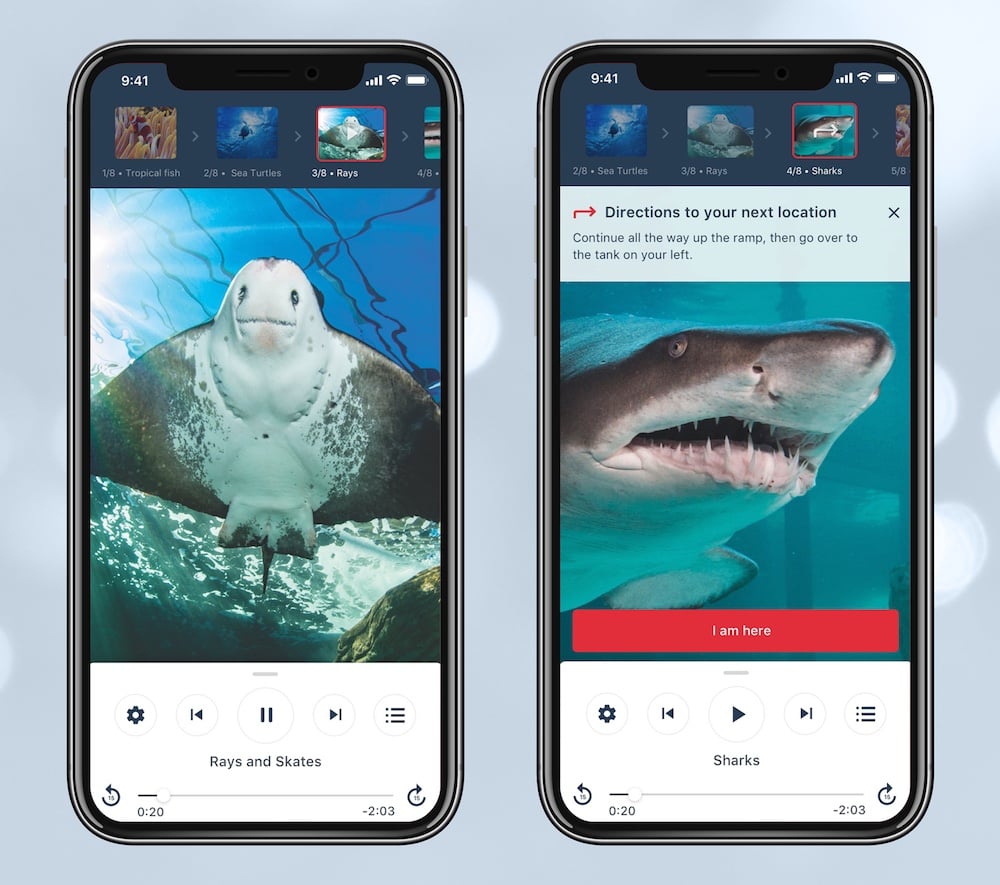Every tour consists of two types of locations: ones that are content-driven and feed the narrative of the tour and ones that are purely directional. While both types include directions, the purely directional types of locations are usually much shorter and only provide the immediate directions needed to get the listener to the next point of interest like this example from our Cambridge Colleges tour.
When you give directions, it’s important to remember that you know where listeners are and to use that information to keep things simple and conversational. The part of the tutorial that explained choosing locations suggested that you imagine using arrow signs, with nothing but instructions to turn left or right. This is because most people don’t know where north, south, east or west is and so it’s best to avoid using cardinal directions unless absolutely necessary.
Walkings tours #
Walking tours require immediate turn-by-turn directions. Think about how you’d provide directions over the phone to someone who is walking. You’d get the listener to spot a landmark, and using that you’d get them to the next point. You’d then wait until they’re there to provide the next bit of direction. Our walking tours use the same principles but with a narrative that builds woven in between the directions.
In the conversation below, and you’ll notice that everything the listener says is telling you where they are. With VoiceMap, their GPS receiver is doing exactly the same thing, and if you place locations carefully, your directions can be equally simple and conversational.
Listener: I’m standing at the corner of Long Street and Wale Street.
You: Okay, face the mountain and turn left.
Listener: Okay, I’ve turned, and I’m walking past a church now.
You: Just past it, you’ll see the entrance to the Company’s Garden. It’s a brick-paved avenue. Turn right when you get there.
Listener: I’m on the brick-paved avenue now, and I’ve walked up a bit. I can see a small gate off to the right.
You: Go into the small gate to your right, and up ahead you’ll see a tall tree. I’ll meet you there.
Two Examples
The first, with all the directions to the next location given at once
Script
Walk until you reach the corner of Example Avenue and For Instance Street. Cross at the lights and turn north. After three blocks, look for Anywhere Lane on the right. Follow it for about a minute and you’ll see Some Place on your left. Go inside it and have a look around! It’s really worth your time. Carry on now, and in about 300 meters you’ll get to Some Other Place.
The second, with the directions split up to play at different locations
Script
Carry on walking now.
Cross the street here, at the lights, and turn left.
Turn right here, onto Anywhere Lane.
Some Place is on your left. You can go inside if you like. When you’re ready to leave, just carry on up Anywhere Lane.
Driving tours #
Directions for driving tours need to be given with far more advance notice than a walking tour. For instance, if a listener needs to change lanes in order to take an off-ramp or make a left turn, they need to hear this with enough time to make the lane change and indicate their intent to other vehicles. This is especially true if there is traffic. A good rule of thumb is to give about 40-50 meters (about 130 to 160 feet) notice to let the listener know a turn is coming up. For highway off-ramps, this should be extended to about 500 meters (about 1640 feet) before the exit.
On your driving tour, there might be a great little diner you think is worth checking out or a must-see attraction that provides a great photo opportunity. With clear instructions ahead of time, these can easily be included on the tour. The listener can have the option to stop at the diner to have a bite, and resume the tour from that spot when they are ready to get going again or continue on with the tour if they prefer. Your editor can help you with the logistics of arranging a stop.
Train tours #
Train tours don’t require turn by turn directions, like walking or driving tours, but still require you to orientate the listener (Coming up on your right is…). This means the same content can be used for train tours that go up and down a set route, but the orientation would need to change, e.g. what was on the right will now be on the left.
Boat and ferry tours #
Some boat tours, such as ferry tours, for example, don’t require turn by turn directions but may require changes to orientating the listener if the tour goes up and down a river route. The same content can be tailored to work for a tour that goes up and down a river.
For self-guided boat tours, such as on a kayak, the exact route a boat follows can vary, location sizes might need to be larger to accommodate the variation in the route, for example, if the route goes up the middle of a river or along a riverbank.
Indoor tours #
When the listener starts an indoor tour, an image of what they should be standing in front of will be on their screen. Directions to the next location will pop up on their screen five seconds before the track ends. When they reach the location and they’re standing in front of the image displayed on their screen, they can hit the play button to start the next track. This sequence will continue until they have listened to all the tracks on the tour.

